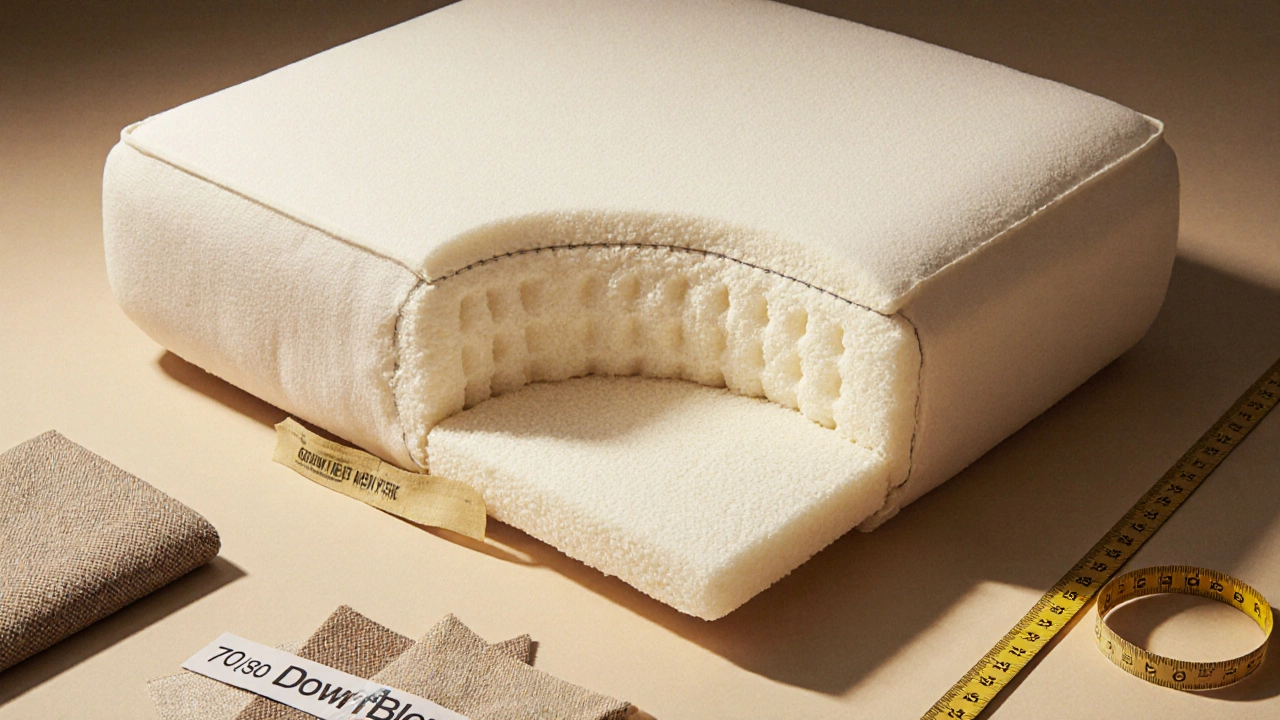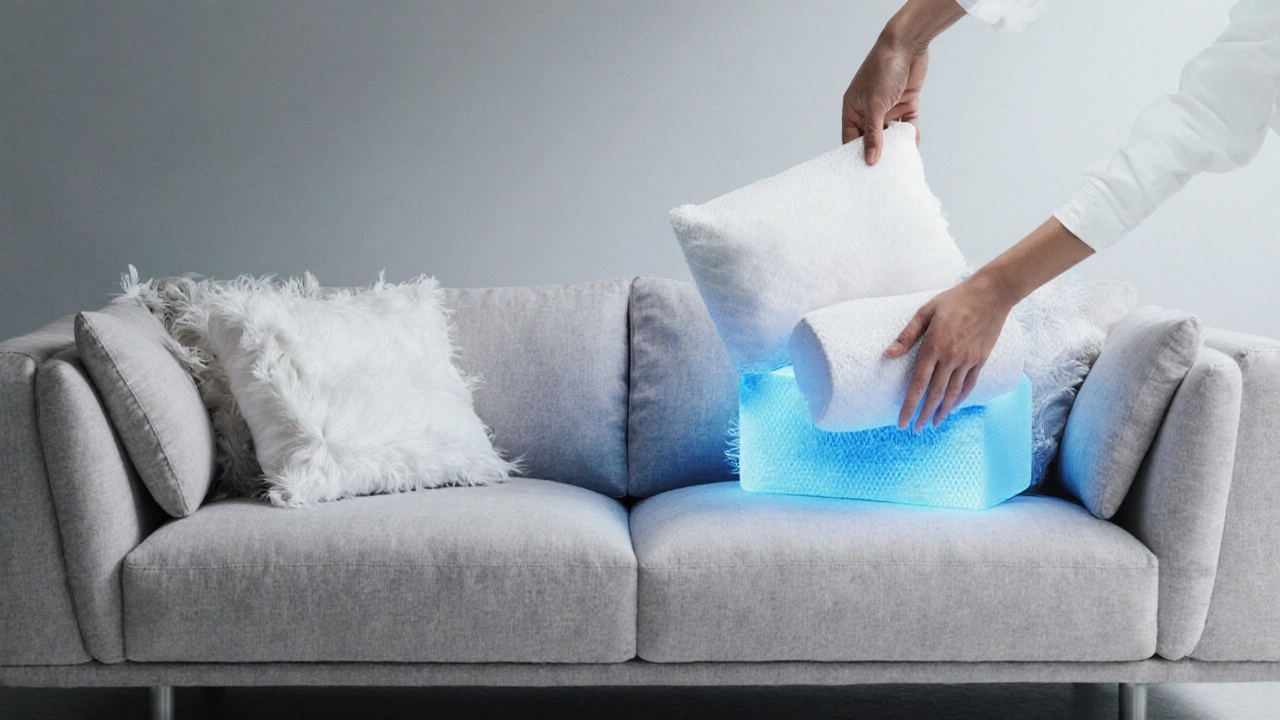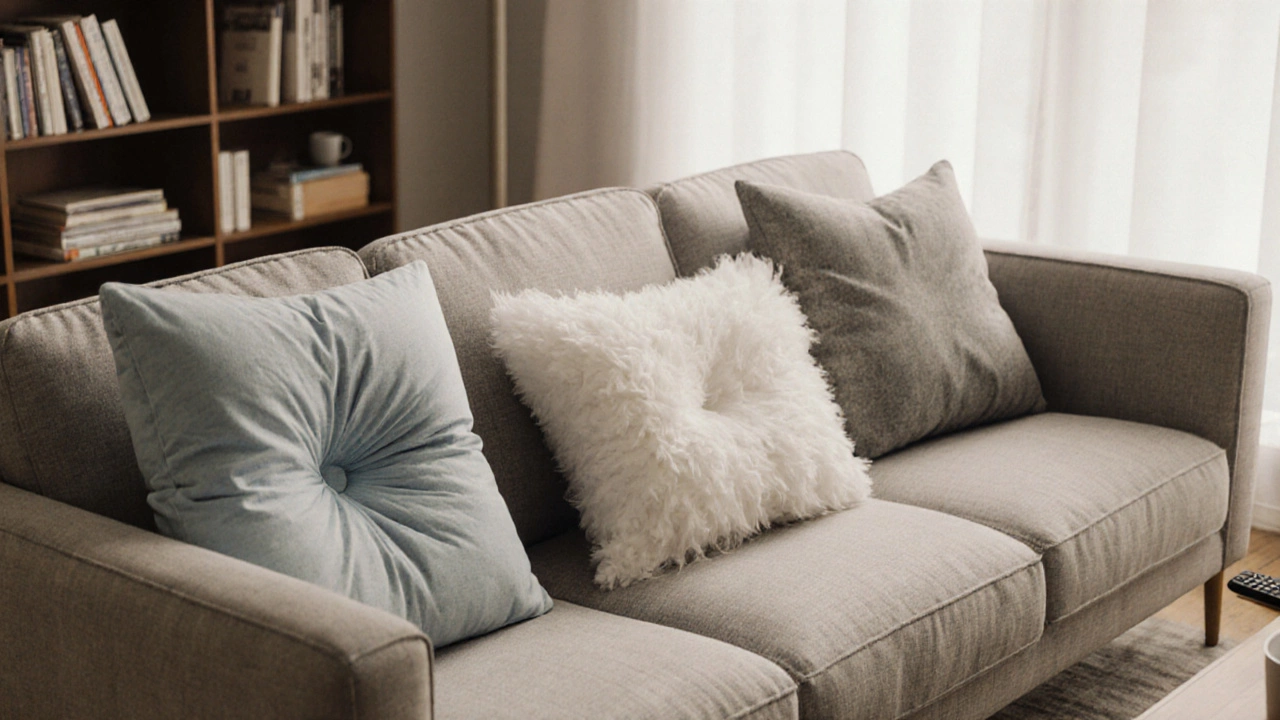Cushion Filling Recommender
Find your ideal sofa cushion filling based on how you use your sofa, your budget, and comfort preferences.
Your Lifestyle Factors
Recommended Filling Type
Ever sat down on your sofa only to feel like you’re sinking into a hammock that forgot to hold its shape? That’s not just bad luck-it’s probably the filling inside your seat cushions giving up. The right cushion filling doesn’t just make your sofa comfy; it keeps it looking new for years. But with so many options out there-memory foam, down, polyester, hybrid blends-it’s easy to get lost. Let’s cut through the noise and show you exactly what works, what doesn’t, and what’s worth spending extra on.
Why Cushion Filling Matters More Than You Think
Most people focus on fabric when buying a sofa. But the filling underneath is what actually decides how long your sofa lasts and how good it feels after five years of Netflix marathons. A cheap fill might feel soft at first, but it’ll flatten out in months. A good one holds its shape, bounces back, and supports your body without making you feel like you’re sitting on a brick.
Here’s the truth: cushion filling isn’t one-size-fits-all. Your ideal choice depends on how often you use the sofa, your body type, whether you like a plush or firm feel, and how much you’re willing to invest. There’s no magic bullet-but there are clear winners based on real-world use.
Memory Foam: The Support King
If you want your seat to hug your body without collapsing, memory foam is the top pick. High-density memory foam (at least 2.5 lb/ft³) molds to your shape and slowly returns to its original form. It’s great for people who sit for long hours, have back pain, or just hate the feeling of sinking into a couch.
Brands like Tempur-Pedic and high-end furniture makers use this in their premium sofas. You’ll notice the difference immediately: no more bottoming out, no more lumps forming in the middle. But it’s not perfect. Memory foam can get warm in summer, and lower-density versions (under 2.0 lb/ft³) will sag faster than a cheap mattress.
Best for: People who want firm support, back pain relief, or long-term durability. Avoid if you live in a hot climate and hate feeling stuck in your seat.
Down and Feather: The Luxury Plush
Down-filled cushions feel like sitting on a cloud. They’re soft, airy, and have that luxurious sink-in quality that makes people say, “I could nap here forever.” This is the go-to for high-end sofas in luxury homes and hotels.
But here’s the catch: down needs maintenance. Without a good inner bag (called a baffle box construction), the feathers shift and clump, leaving bald spots. You’ll need to fluff them daily-or at least weekly-to keep them even. And if you’re allergic, forget it. Even hypoallergenic down can trigger reactions over time.
Real tip: Look for a 70/30 or 80/20 down-to-feather ratio. More down means softer, lighter, and longer-lasting. Anything with more than 30% feathers will feel lumpy and lose shape fast.
Best for: Those who love plush, soft seating and don’t mind a little upkeep. Not ideal for families with kids, pets, or allergies.

Polyester Fiber: The Budget-Friendly Workhorse
Most mid-range sofas come with polyester fiber fill. It’s cheap, easy to clean, and holds up okay if you’re not sitting on it 10 hours a day. It’s the default choice for IKEA, Ashley, and other mass-market brands.
The problem? It flattens. Fast. After six months, you’ll start noticing the cushions sagging in the center. By year two, they’ll look like deflated balloons. Higher-end polyester blends (like Dacron or high-loft polyester) last longer and resist compression better, but they still won’t match foam or down.
Pro tip: If you’re stuck with polyester, look for cushions with a thick inner foam core wrapped in fiber. That combo gives you a little bounce and prevents the fiber from collapsing completely.
Best for: Light use, rental homes, or tight budgets. Not a long-term solution.
Hybrid Fills: The Smart Middle Ground
The smartest option for most people? A hybrid fill. Think foam core wrapped in a layer of down or fiber. This gives you the support of foam with the softness of down. You get the best of both worlds: no sinking, no flattening, and a plush feel that doesn’t require daily fluffing.
For example, a 3-inch high-density foam base with a 1-inch down-blend wrap is a common setup in premium sofas like those from Crate & Barrel or West Elm. These cushions last 7-10 years without losing shape. They’re also easier to clean than pure down and don’t trap heat like foam alone.
Hybrids are the most popular choice among interior designers in New Zealand and Australia. Why? They handle real life-kids, pets, movie nights, naps-without falling apart.
What to Avoid
Not all fills are created equal. Here’s what to skip:
- Low-density foam (under 1.8 lb/ft³) - It compresses in weeks. You’ll see it in cheap online sofas.
- 100% feather fill - Too lumpy. Feathers don’t provide support. They just make your seat feel uneven.
- Styrofoam beads - They shift around, make noise, and eventually leak out through seams.
- Unwrapped fiber - Just fiber with no foam core? That’s a fast track to a flat cushion.

How to Test a Cushion Before You Buy
Don’t just sit on it. Test it like a pro:
- Press down hard with your hand. If it bottoms out instantly, avoid it. Good foam should push back.
- Check the seams - Are they stitched tightly? Loose stitching means the fill will leak out over time.
- Look for removable covers - You’ll need to wash or replace them eventually. Non-removable? Big red flag.
- Ask for density specs - If the salesperson can’t tell you the foam density or down ratio, walk away.
- Check the weight - A well-filled cushion should feel substantial. If it’s light, it’s probably underfilled.
Replacement Tips: When Your Cushions Are Done
You don’t need to buy a whole new sofa if your cushions are flat. Replacing them is often cheaper-and easier-than you think.
Measure your current cushions (length, width, depth). Then order new ones online from specialty suppliers like Cushion Source, Upholstery Supply, or even Etsy sellers who make custom fills. You can choose your exact foam density, down blend, or hybrid setup.
Most people spend $50-$150 to replace four cushions. A new sofa? That’s $2,000+. Replacing the fill is the smarter move.
Final Verdict: What’s the Best Filling?
Here’s the simple answer:
- Best overall: High-density foam core with a down-blend wrap (hybrid)
- Best for support: 2.5+ lb/ft³ memory foam
- Best for luxury feel: 70/30 down-to-feather ratio in baffle-box construction
- Best budget option: High-loft polyester with a foam core
Forget the hype. The best filling isn’t the most expensive-it’s the one that matches your lifestyle. If you’re active, have kids, or sit for hours, go foam or hybrid. If you want a spa-like lounge experience and don’t mind fluffing, go down. Skip the cheap stuff. It’s not saving you money-it’s just delaying the next purchase.
How long should sofa cushions last with good filling?
With high-quality filling like high-density foam or down-blend hybrids, sofa cushions should last 7 to 10 years with normal use. Cheaper fills like low-density foam or plain polyester start flattening in 1 to 2 years. Regular fluffing and rotating cushions can extend their life by up to 30%.
Can I mix different fillings in one sofa?
Yes, and many premium sofas do exactly that. For example, the back cushions often use down or fiber for softness, while seat cushions use foam for support. Mixing fills is smart because different parts of the sofa need different performance. Just make sure the transition between fills is smooth-no sudden lumps or gaps.
Is memory foam too hot for a sofa?
Traditional memory foam can retain heat, but newer open-cell or gel-infused memory foams are designed to breathe better. If you live in a warm climate like Auckland, look for foams labeled "cooling" or "ventilated." Avoid thick, solid memory foam without airflow channels.
Do I need to wash sofa cushion fills?
No-you never wash the fill itself. Only the removable covers. Foam and down should never get wet. If the cushion gets stained, spot-clean the cover and let the fill air out. Moisture can cause mold in foam and clumping in down. Always check the care label before cleaning.
Why do some cushions feel firm at first but soften over time?
That’s normal with high-density foam. It takes 2-4 weeks of regular use to fully break in. The foam compresses slightly and molds to your body shape, becoming more comfortable without losing support. If it softens too much after a few months, the foam was probably too low in density to begin with.

